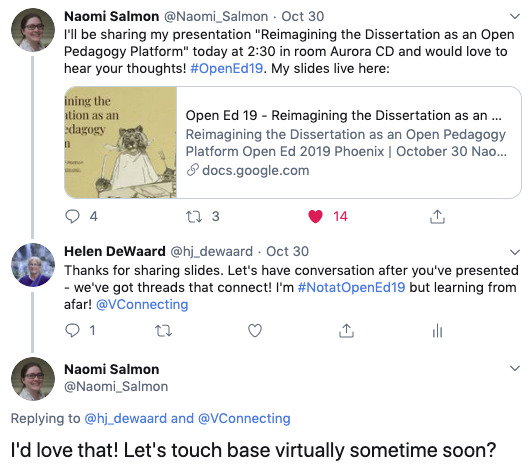Are we OPEN yet?
This is a reading response for the Research Colloquium course for week nine. I am responding to Willinsky’s (2014) notion of openness in educational research. This is a timely reading and response, where I can also reflect on my recent engagement with speakers and presenters at the Open Education Conference 2019 held in Phoenix, Arizona. Willinsky exhorts researchers to “reach out further, beyond the circle” but how is this done? One way I did this was using Twitter to track and observe conversations from others attending the conference since hashtags help bring conversations together. Using the #OpenEd19, #GoOpen and @VConnecting tags, I was able to openly engage with others at the conference.
Willinsky (2014) suggests that what it means to “make one’s research public is changing conceptually as well as technologically” (p. 680). In order to reach an audience beyond the print bound mediums currently privileged in academia, researchers need to share beyond the boundaries of journals and conference presentations. As exemplified by Naomi Salmon at the Open Ed Conference, researchers need to risk putting themselves ‘out there’. Her tweet about her conference presentation allowed me to connect to her work, since it is something I had already examined for my research proposal. I was able to reach out and receive a response from Naomi beyond the traditional communication channels.

My interest in her research precedes this encounter because it was openly available on the web [Dissertation Form Proposal]. My engagement with Naomi Salmon in this brief interaction will extend her work in reimagining the dissertation and enhance my understanding of the process and products of opening the dissertation. In this way, we are fulfilling Willinsky’s premise that researchers can “greatly increase the quality and quantity of information available that might inform educational questions and discussions” (p. 678). Salmon continues to extend this opportunity to move more fully into the open and public sphere (Willinsky, 2014) with this series of tweets from the conference (see 1/6 which links down to 6/6).
This is one call from one researcher, at one moment in time, Imagine the potential when others provide opportunities such as this one, since it is “vital to offer future scholars opportunities to engage with multimodal inquiry, within a context that is supportive, open, flexible and respectful of equity and diversity of knowledge” (Literat et al., 2018). Willinsky’s vision is only the beginning.
References
Literat, I., Conover, A., Herbert-Wasson, E., Kirsch Page, K., Riina-Ferrie, J., Stephens, R., Thanapornsangsuth, S., & Vasudevan, L., (2018). Toward multimodal inquiry: opportunities, challenges and implications of multimodality for research and scholarship, Higher Education Research & Development, 37(3), 565-578, DOI: 10.1080/07294360.2017.1389857
Salmon, N. (2019). OER activity sourcebook. Retrieved from https://wisc.pb.unizin.org/oersourcebook/
Salmon, N. (2018). Dissertation form proposal. Retrieved from https://wisc.pb.unizin.org/nsalmondissertationformproposal/#main
Willinsky, J. (2014). The New Openness in Educational Research. In M. Peters, E. Hart, & A. Reid (Eds.), A Companion to Research in Education (pp. 575–582). Dordrecht: Springer Science+Business Media. https://doi.org/10.1007/978-94-007-6809-3_75
Image attribution: Photo by Artem Beliaikin on Unsplash
